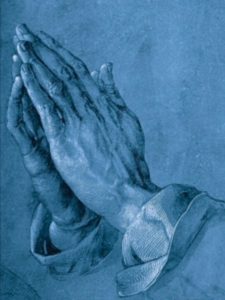by Dcs. Carolyn S. Brinkley
 The Praying Hands is a unique icon in Western art that has transcended the sacred and entered the world of pop culture. It is seen on almost every kind of object imaginable: tattoos, necklaces, bumper stickers, clip art, plaques, charm bracelets, tee-shirts, bookends, street art, afghans, cremation urns, soap, and even the tombstone of Andy Warhol. The image has been executed in nearly every medium from ink, paint, wood, plaster, stained glass, and copper to embroidery, crochet thread, and even dot to dot coloring books. Why this fascination with the Praying Hands? Where did the image begin? Who made it and why?
The Praying Hands is a unique icon in Western art that has transcended the sacred and entered the world of pop culture. It is seen on almost every kind of object imaginable: tattoos, necklaces, bumper stickers, clip art, plaques, charm bracelets, tee-shirts, bookends, street art, afghans, cremation urns, soap, and even the tombstone of Andy Warhol. The image has been executed in nearly every medium from ink, paint, wood, plaster, stained glass, and copper to embroidery, crochet thread, and even dot to dot coloring books. Why this fascination with the Praying Hands? Where did the image begin? Who made it and why?
Surprisingly, Praying Hands is over 500 years old and was only a preliminary drawing by Albrecht Dürer for a much larger work. In 1507, he was commissioned by Jacob Heller to paint a triptych altar piece on the assumption and coronation of the Virgin Mary for a church in Frankfurt. The Praying Hands, so beloved today, was merely a sketched pattern Dürer used for the hands of an apostle kneeling near her tomb. Due to complications, the Heller altar piece was not finished until 1509. Tense relations between artist and patron over the extended length of time required for its completion along with Dürer’s insistence that he be compensated for additional expenses resulted in a series of extant letters including a guarantee on the workmanship and durability of his painting. “I have painted it with great care, as you will see, using none but the best colours I could get. If it is kept clean I know it will remain bright and fresh 500 years, for it is not done as men are wont to paint. So have it kept clean and don’t let it be touched or sprinkled with holy water.”[i] Ironically the original sketch of the Praying Hands still exists, but the Heller altar piece was destroyed by fire in 1729, after it was moved to the Residenz in Munich. Thankfully, Jobst Harrach copied the painting in 1614, before it left Frankfurt.
Why the appeal of this simple drawing of clasped hands seemingly floating on blue paper? Why is it ubiquitous in our culture? First of all, it is a beautiful piece of art. The details are exquisite. Although the sketch was never intended for any purpose other than to be his own guide and pattern, Dürer drew every detail. That was his style: precise, meticulous, and perfectly proportioned. He loved the intricate features of God’s creation and took great pains to capture them in his religious scenes, portraits, landscapes, and still life of plants and animals.
 Secondly, these hands have universal appeal. They are working hands with cuffs of the common man or woman. Some have speculated that Dürer used his mother as a model and others conjecture that they are the hands of the artist, but the truth is, they could be yours, mine, or anyone’s. Dürer’s remarkable genius for making the individual feel that they are an integral part of his visual expression continues to this very day.
Secondly, these hands have universal appeal. They are working hands with cuffs of the common man or woman. Some have speculated that Dürer used his mother as a model and others conjecture that they are the hands of the artist, but the truth is, they could be yours, mine, or anyone’s. Dürer’s remarkable genius for making the individual feel that they are an integral part of his visual expression continues to this very day.
Finally, the Praying Hands have an incredible spiritual dimension that touches the very essence of mankind and our need for mercy. The textured veins and fingers become a Gothic spire leading the eye upward. Added to this, the brush drawing is heightened and intensified with white. This makes the hands glow with light and life from above. In one simple sketch we see the whole story. We see our story. We see our helplessness and plea for mercy. We see God’s mercy in Christ, the One who pleads for us from above.
Deaconess Carolyn S. Brinkley is the Military Project Coordinator at Concordia Theological Seminary, Fort Wayne, Ind.
Additional information on Albrecht Durer’s Praying Hands:
Today, the Praying Hands (11.5″ x 7.8″) is housed at the Albertina in Vienna, Austria. Due to the fragility and age of the original sketch, only a facsimile is displayed for the public.
A false story of the origin of the Praying Hands has been widely circulated for many years. In this work of fiction, Dürer comes from a poor family of 18 children. Albrecht and his brother both desired to be artists, but since there was no money for art school, the older brother went to work in the mines to pay for the cost of Albrecht’s education. The roles were then to be reversed. But alas, the brother’s hard work ruined his hands and the chance of ever becoming an artist. In tribute to his sacrifice Albrecht sketched his brother’s hands. Most likely this fictional account of the Praying Hands was constructed in the 19th century when there was a renewed interest in Albrecht Dürer and his work.
[i] William Martin Conway, Tr. and Ed. The Writings of Albrecht Dürer, (New York :Philosophical Library, 1958),69.
